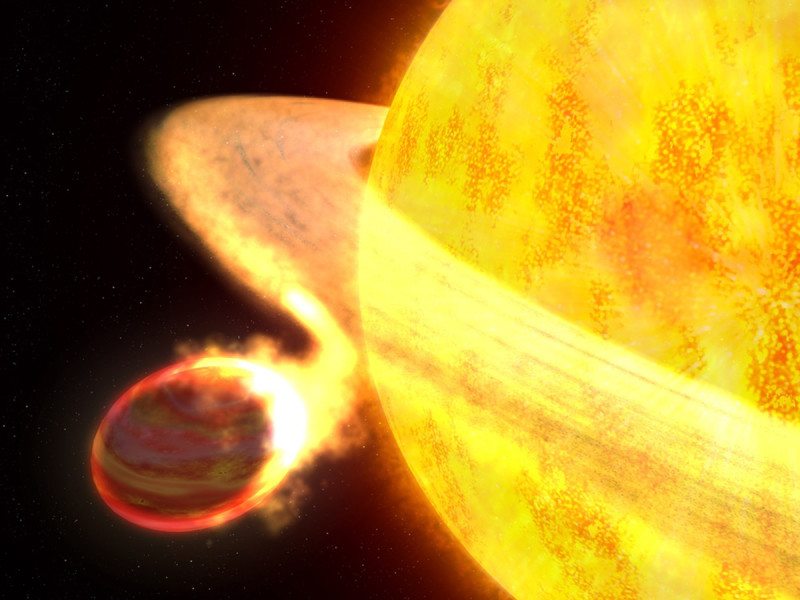
The gas giant is rapidly losing its atmosphere
This new exoplanet is too hot to handle. At twice the size of Jupiter and with
temperatures reaching 4600 kelvin (over 4300°C), KELT-9b is the warmest
world ever discovered.
Finding exoplanets around stars much hotter than the sun is difficult. This is because
the blinding brightness and rapid spinning of stars like the one KELT-9b
orbits can obscure the relatively minuscule changes to their light that passing
planets cause.
Furthermore, most worlds orbiting such hot stars have no chance of being habitable,
so the search for exoplanets has largely focused on dimmer, cooler stars in recent
years.
When B. Scott Gaudi at The Ohio State University and his colleagues started using
the Kilodegree Extremely Little Telescope (KELT) to look for exoplanets passing
in front of relatively cool stars, they kept seeing planets that had already been
discovered.
So instead, they decided to focus on hotter, brighter stars with more extreme planets.
“In some sense, it’s a race to the bottom: finding the smallest planets around the
smallest stars because those are the ones that might be habitable,” says Gaudi.
“What our collaboration likes to say is that there’s room at the top.”
Gaudi and his team detected KELT-9b by observing the dip in light as the
planet passed between us and its star, which is about 650 light years away
and almost twice as hot as the sun. It is by far the hottest, brightest and most
massive star around which we’ve ever found a planet in this way.
Short orbit
Given the star’s temperature, it is unsurprising that its planet is the hottest we’ve
discovered. With an orbit of merely an Earth day-and-a-half or so, KELT-9b is very
close to its star and likely to be tidally locked, with a dayside always facing the star
and a cooler nightside always pointing away.
As a result, its dayside is constantly bombarded by heat and bright, high-energy blue
and ultraviolet light. This makes the dayside surface as hot as a relatively warm star,
while the nightside is still hotter than the most tepid stars, like our cosmic neighbour
Proxima Centauri (which has at least one exoplanet of it
KELT-9b is heated from the outside rather than from internal atomic fusion,
so it will never become a star, but it probably looks like a bright ember.
“The planet’s dayside, which is facing the star, is going to glow a bright orange,
and then on the nightside, it’s going to be deep, dark red,” says Gaudi.
“This planet is much hotter than most stars in the universe,” says David Charbonneau
at Harvard University. “It is intriguing to consider how it formed and what its
ultimate
fate will be.”
Vanishing atmosphere
The star’s intense light and heat are enough to evaporate the gas giant’s atmosphere
at a rate of up to 10 million tonnes per second, which may render the planet a naked
core by the time its star expands and envelops it.
One of the greatest mysteries in the study of exoplanets are the atmospheres of hot
gas giants. Luckily, KELT-9b has a towering atmosphere that absorbs some of the light
from its particularly bright star, making it a prime candidate for additional observations by
both ground and space-based telescopes.
“Finding a wider range of these planets, especially ones that are amenable to further
study like this one, is really important to trying to understand these types of worlds,”
says Gaudi.
And although KELT-9b is the hottest exoplanet found so far, Gaudi hopes its discovery
will encourage researchers to examine more big, hot stars in the hunt for even stranger
“The diversity of planets orbiting other stars is humbling,” says Charbonneau.
“Whenever I think, ‘No, there couldn’t possibly be a planet there’, sure enough one turns up.”
(New Scientist)

No comments:
Post a Comment